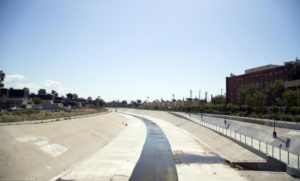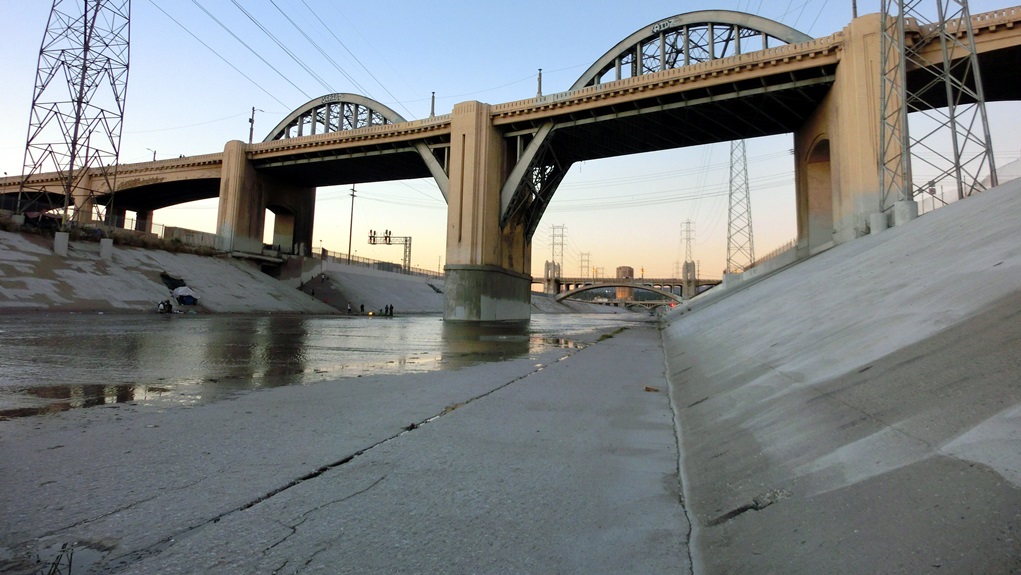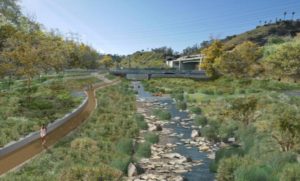I (Storm) have been describing the restoration of the Los Angeles River—and the revitalization of surrounding neighborhoods that were devitalized by this hideous, unhealthy, over-engineered 51-mile scar on the face of Los Angeles County—for as long as I’ve been writing books and doing talks and workshops on community revitalization and natural resource restoration (over two decades).
 Many folks in the Los Angeles city and county governments–along with the U.S. Army Corps of Engineers and many local non-profits, such as the recently-renamed River LA (formerly the Los Angeles River Revitalization Corporation)—have been working hard the entire time. Yet a casual observer could be forgiven if they asked “why isn’t anything happening?“.
Many folks in the Los Angeles city and county governments–along with the U.S. Army Corps of Engineers and many local non-profits, such as the recently-renamed River LA (formerly the Los Angeles River Revitalization Corporation)—have been working hard the entire time. Yet a casual observer could be forgiven if they asked “why isn’t anything happening?“.
I’ve spoken with many of the civic leaders and private engineering firms who were heading-up various aspects of the project over the years. Ira Artz of Tetra Tech was one of the first, many years ago, and the most recent (this month) was Eli Kaufman, Creative Director at River LA. All of the conversations had similar threads: excitement and optimism, tinged with awareness of some harsh realities.
The challenges are many and varied. Some are legal, business, and human challenges: multiple jurisdictions; diverse property owners (from private to the federal government); land speculators; NIMBYism; etc. Others are physical, with the biggest one being contamination. Much of the river has been lined with industry over the past century, and many of those businesses left toxic soil in their wake.
Before anyone can think about turning these properties into public parks, condos, or healthy ecosystems, those poisons must be removed and/or remediated. Several decades after the creation of the multi-billion-dollar brownfields remediation/redevelopment industry (launched in the U.S. by the EPA in the mid-90s, and possibly the most effective and efficient federal program in the nation’s history), the science and practice of remediation is well-established.
The challenge here is money. Remediation—whether in situ or ex situ, chemical or phyto-based—is expensive, and the companies that polluted this land have long since either gone out of business, or have decalred bankruptcy and re-formed in order to avoid paying for the cleanup.
 A recent example of stymied progress: Sandwiched between Rio de Los Angeles State Park and an unusually verdant meander of the L.A. River in Glassell Park, you will find the crumbling remains of a railroad empire. Littered with rocks, rubble, and the occasional old rail tie, the 41-and-a-half-acre plot of land—known officially as the G2 parcel—is the last vestige of Taylor Yard, a freight-switching facility that was the core of the Southern Pacific Railroad’s L.A. operation for about 60 years.
A recent example of stymied progress: Sandwiched between Rio de Los Angeles State Park and an unusually verdant meander of the L.A. River in Glassell Park, you will find the crumbling remains of a railroad empire. Littered with rocks, rubble, and the occasional old rail tie, the 41-and-a-half-acre plot of land—known officially as the G2 parcel—is the last vestige of Taylor Yard, a freight-switching facility that was the core of the Southern Pacific Railroad’s L.A. operation for about 60 years.
The City of Los Angeles, in conjunction with the U.S. Army Corps of Engineers, prepared the Final Integrated Feasibility Report (IFR), which includes the Final Feasibility Report and Environmental Impact Statement (EIS)/Environmental Impact Report (EIR) for the proposed Los Angeles River Ecosystem Restoration Project. Los Angeles City Council adopted the Study on June 29, 2016.
The proposed Project involves restoring 11 miles of the Los Angeles River from approximately Griffith Park to downtown Los Angeles, while maintaining existing levels of flood risk management. Restoration measures considered include creation and reestablishment of historic riparian strand and freshwater marsh habitat to support increased populations of wildlife and enhance habitat connectivity within the study area, as well as to provide opportunities for connectivity to ecological zones, such as the Santa Monica Mountains, Verdugo Hills, Elysian Hills, and San Gabriel Mountains.
Restoration includes the reintroduction of ecological and physical processes, such as a more natural hydrologic and hydraulic regime that reconnects the river to historic floodplains and tributaries, reduced flow velocities, increased infiltration, improved natural sediment processes, and improved water quality. The proposed Project also includes opportunities for passive recreation that is compatible with the restored environment.
But just securing the land took decades. After Taylor Yard shut down in the 1980s, city officials and river activists began a fight to reclaim the property from Union Pacific (which bought Southern Pacific), to the tune of $59.3 million. If everything goes as planned, the parcel will connect Rio de Los Angeles State Park with the state-owned G1 (or “Bowtie”) parcel to the north, opening up more than a mile of river access in a historically working-class neighborhood and allowing for a large swath of the river’s ecosystem to be restored.
But as with so many sites across the region, its soil is polluted to high hell—in this case, with contaminants from the maintenance shop that once stood there. In nearby Lincoln Heights, crews spent six years and $6.2 million cleaning up the site of an old dairy distribution plant to make way for Albion Riverside Park, set to open in 2019.
The story was similar across the river at L.A. State Historic Park, which had its reopening delayed for years due to toxins from another rail yard.
California State Parks superintendent Sean Woods, who oversaw that effort, says “the great unknowns that you find below the surface” make these projects expensive and unpredictable. “When you’re converting brownfields in urban areas, it’s just an exponential cost.”
Estimates are that it’ll take $252 million to transform G2 into clean park space. So far city hall has secured around $22 million to that end, which is to say, you shouldn’t pack a picnic just yet.
But the slow pace of progress doesn’t mean the people are working on it slowly. Most are fired-up by a clear and inspiring vision of what a restored river will mean for the city “The Los Angeles River is a public resource and a great opportunity for Angelenos to share space,” said Eli Kaufman, in an interview for REVITALIZATION. “The challenge is to serve all the diverse needs of the communities of our region with a healthy, vibrant and resilient river that connects Angelenos to water, the environment, and to each other.”
All photos courtesy of LA River except the featured photo, which comes via Adobe Stock.



